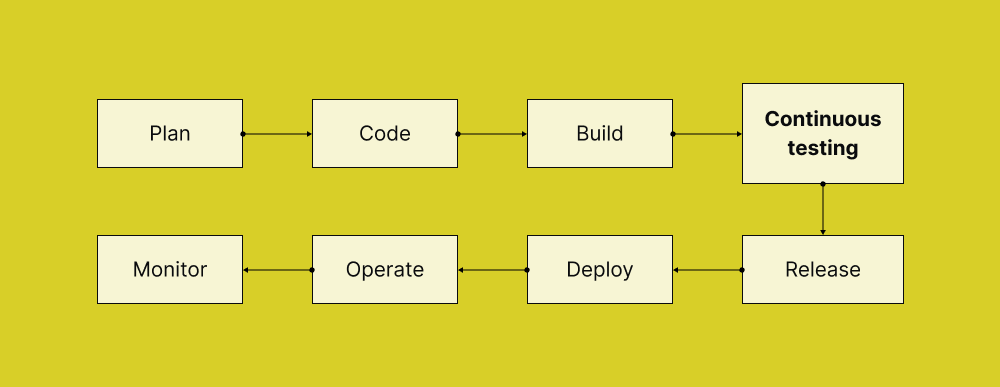-
How we help
- Does my software work?
- Does it work for all users?
- Global Growth Toolbox
- Industries
-
Platform
- Platform
- Integrations
- Browse all test types
- Add-on services
- Pricing
- Resources
Agile Testing Methodology - Best Practices
Agile testing is any test which occurs to support an agile methodology. Below we break down some of the best practices for agile testing in software. If you want to start testing in agile with Global App Testing, you can get in touch on the form to the right. In this article, we’ll go over the following:
- What is Agile testing methodology
- Principles of Agile testing
- Profile and types of Agile testers
- Agile testing life cycle
- Advantages and disadvantages of Agile
- Best practices for Agile testing
Introduction to agile methodology in testing
Agile testing has become the norm for 86% of software developers worldwide, a clear indication of the industry's fundamental shift in creating software. Its overwhelming reception isn't just a mere statistic but a demonstration of a new era in streamlined software development.
This major stride stems from the critical role Agile testing plays in ensuring precision and adaptability, making it an essential force in software development. Understanding its significance and impact is necessary to navigate the new terrain of modern programming.
What is agile software development?
In order to understand agile testing, it’s important to understand what the Agile development methodology involves. It’s an umbrella term, covering many practices that differ from traditional development techniques. Let’s start by looking at the key principles of agile software development. The four core values are:- Focus on people, rather than processes and tools
- A working piece of software is more important than detailed documentation
- Ongoing collaboration with customers matters more than a fixed contract
- Be responsive to change, rather than sticking to a plan
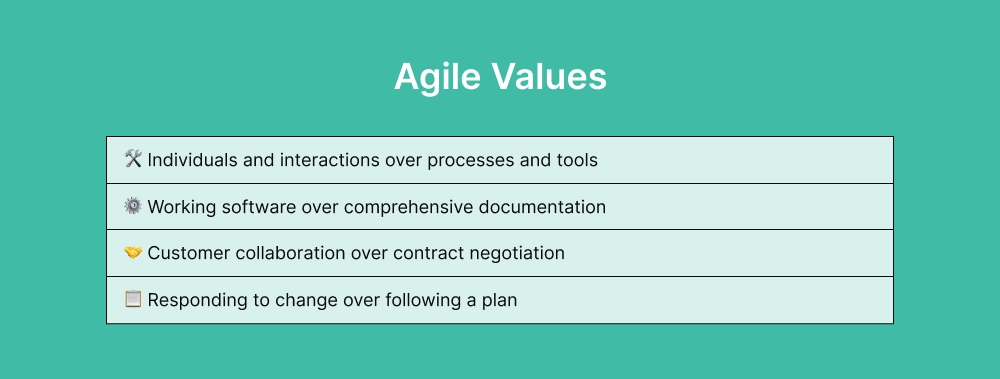
As the name implies, an Agile methodology is focused on responding to change. There are many frameworks teams might use, such as Scrum or Kanban, but at the center of it is a collaborative approach.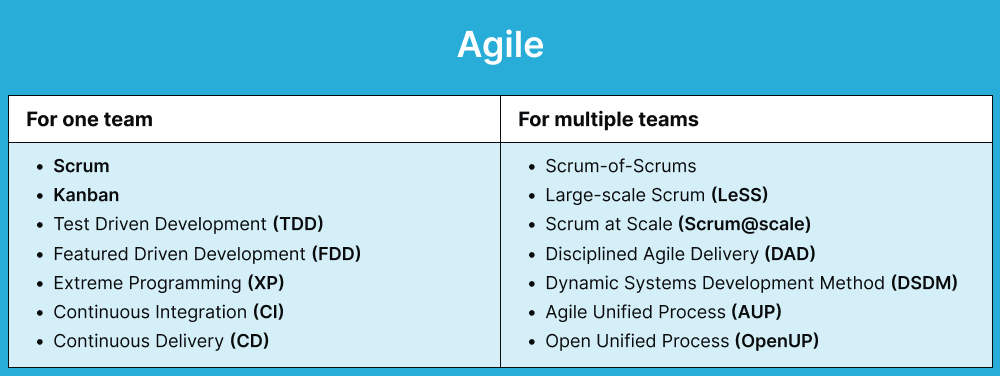
A traditional development approach might separate team members based on the area they’re working on, and slowly add pieces together to create a finished product. With Agile, continuous integration is key - the whole team collaborates and new features are added as they work. It creates a completely different software development life cycle - which is why teams need to implement agile testing methods to help.
Agile testing methodology
By definition, Agile testing methodology refers to the approach and set of practices employed for testing software within an Agile development environment. In the context of Agile, testing is not a separate phase but is seamlessly integrated throughout the software development lifecycle.
The methodology is rooted in the Agile principles outlined in the Agile Manifesto (4 key values we mentioned above and 12 principles we’ll discuss below) and emphasizes collaboration, flexibility, and continuous feedback.

Our interpretation of agile testing is testing that takes place in and is suitable for an agile software development environment. While many types of testing appropriate for other software development methodologies, such as regression testing and feature testing, etc, are also relevant to agile testing, their methodology – how they align with the software release cycle and the approach to planning and understanding success – is often distinct.
Elastic tester supply
Global App Testing offers a tester supply characterized by elasticity and rapid turnaround. This means you can instantly expand your team in situations where tests cannot be automated. Embracing Elastic QA, we merge human expertise with technology, ensuring swift and valuable software testing. Our approach involves integrating third-party QA resources to cater to your team's dynamic testing requirements and release cycles. With a global network of 90,000 testers across 190 countries, we blend automation with a 'human in the loop' to deliver tailored solutions when you need them. How does it work? Global App Testing acts as an additional resource, partnering with your existing QA team. You gain access to our global tester network, allowing you to tap into and out of resources as per your specific needs
Our approach involves integrating third-party QA resources to cater to your team's dynamic testing requirements and release cycles. With a global network of 90,000 testers across 190 countries, we blend automation with a 'human in the loop' to deliver tailored solutions when you need them. How does it work? Global App Testing acts as an additional resource, partnering with your existing QA team. You gain access to our global tester network, allowing you to tap into and out of resources as per your specific needs.
Philosophy of continuous testing
Agile testing operates under the philosophy that continuous testing is an indispensable part of development, equivalent in importance to coding itself. In Agile, testing is integrated into the development process to discover bugs early and frequently. This proactive approach enables testers to identify issues at every stage of development, swiftly propelling the product toward release.
Doing Agile vs. Being Agile
From 2020 to 2021, there was a notable surge in Agile adoption among software development teams, jumping from 37% to 86%.
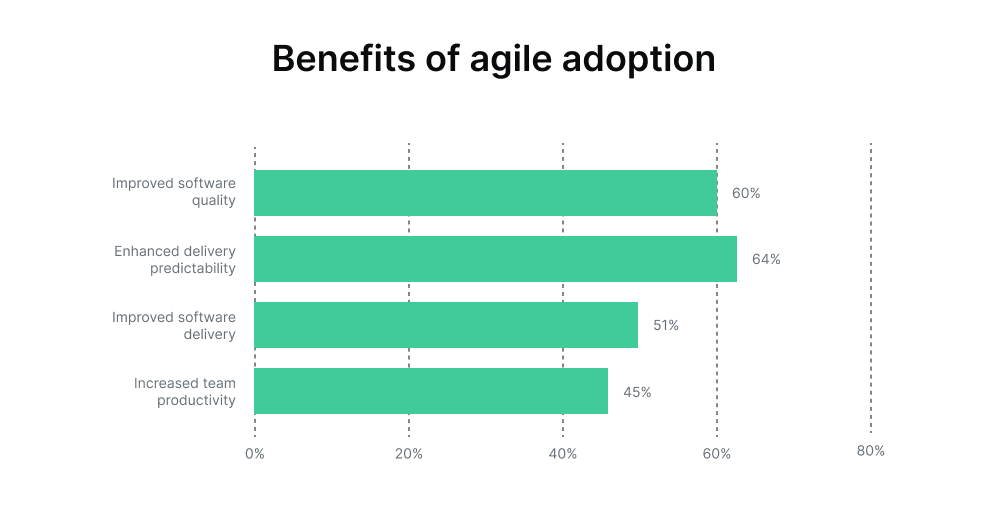
However, merely adopting Agile processes doesn't guarantee an organization is truly Agile.
- "Doing Agile" involves implementing Agile practices, such as using Scrum or Kanban, dividing work into incremental steps, and employing Agile estimation techniques. It reflects the application of Agile frameworks without a full organizational commitment.
- "Being Agile" requires a holistic mindset shift, extending Agile principles to all facets of the business. This transformative approach involves aligning with the Agile Manifesto's core values, fostering adaptability, and nurturing a culture of continuous learning.
Unlike "doing Agile," being truly Agile demands a deeper commitment and substantial effort, with a realization that it's a journey that may span years. It requires breaking away from traditional top-down project management mentalities, embracing flexibility, and fostering an organization-wide Agile mindset.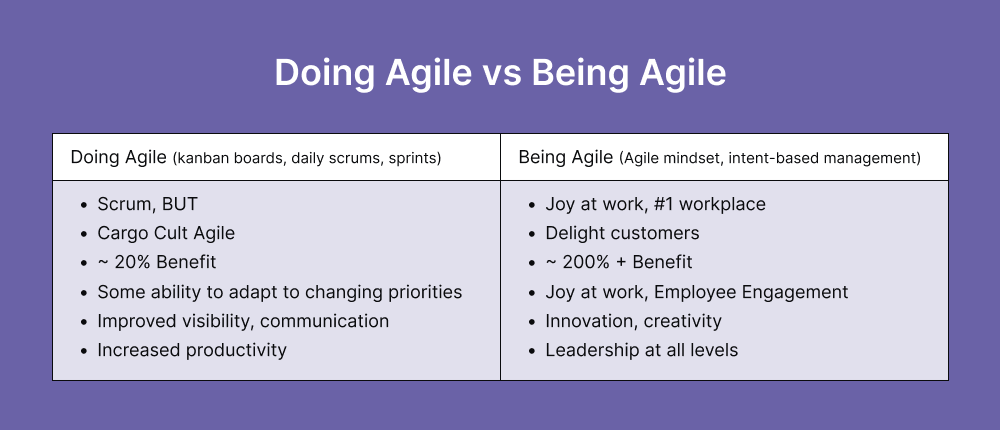
A While doing Agile might involve process implementation, being Agile entails a profound cultural shift, emphasizing the importance of mindset over methodologies. The distinction lies in the depth of commitment and the extent to which Agile principles permeate an organization's DNA.
Traditional testing method vs. agile software testing
To keep things from breaking in the customers’ hands, testers attempt to break it first - and then have it fixed.
In the traditional waterfall method of development, the sequence of events is:
Requirements > System Design > Implementation > Integration and Testing > Deployment of System > Maintenance.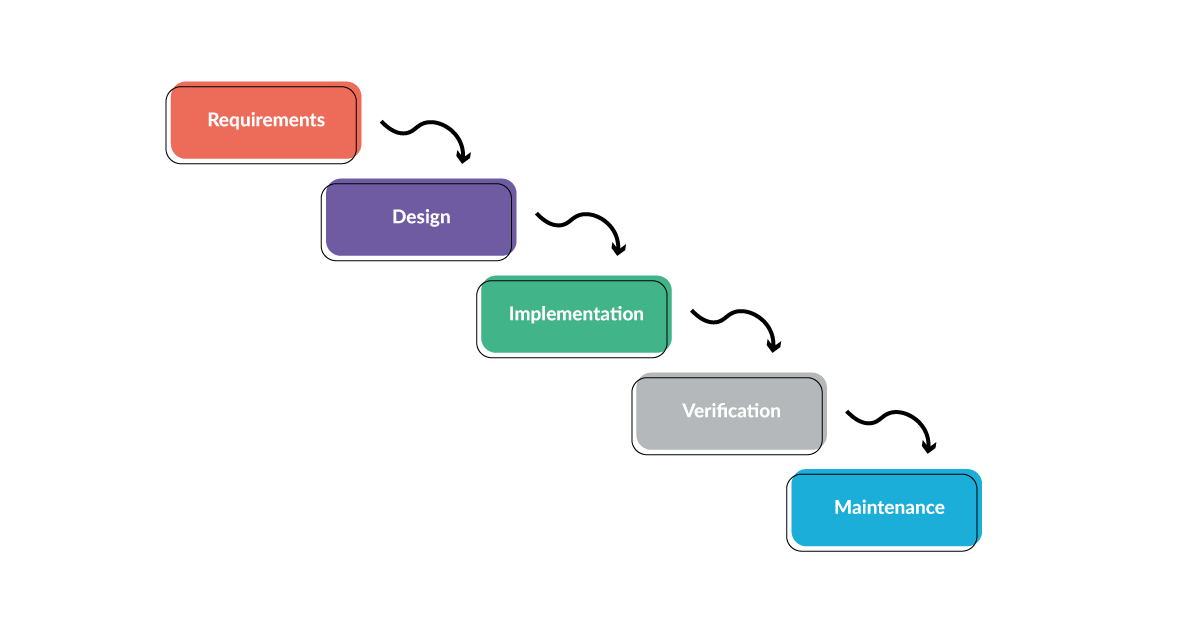
With this method, the next step does not begin until the previous step has been fully completed, which means the testing team doesn’t receive the product until late in the development cycle. This can be a real challenge for your software testing team, as any bugs they catch at this point will be difficult and costly to eradicate from the product.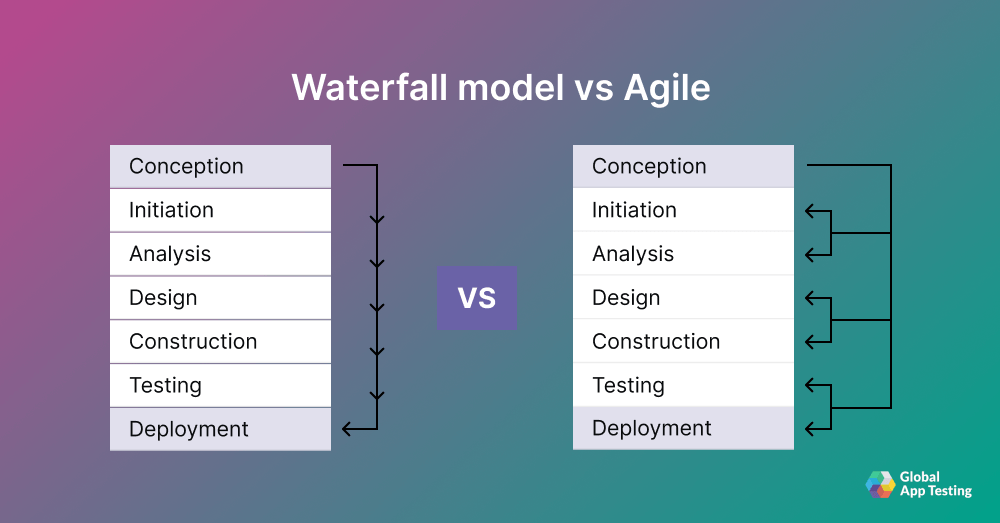
Testers who enter the process at this juncture can also not ask the right questions and perform the right tests because there is little feedback from other development team members (sometimes viewed as ‘the enemy’) or from customers. Testers are forced to simply wait for the product to come down the assembly line (or waterfall), then use a narrow set of skills to decide whether it should be kicked back to a previous step in the development process. With Agile, the test plan is in place throughout. Whenever a new update is made to the code, the test team gets their hands on it, feeding it back directly to the developers. These test cycles can also feature automated tests and a small selection of end users.
Principles of Agile Testing
The 12 Agile principles were introduced subsequent to the manifesto's creation, serving as a roadmap for teams adopting the agile mindset. They serve as benchmarks to evaluate whether current practices align with the agile culture, providing concrete examples of how the agile approach should be implemented.
Here is the summarized version of these principles:
- Test earlier and more frequently. Start testing early as possible (sometimes known as #shiftleft) allows you to fix issues earlier in the software development cycle.
- Automate a greater proportion of tests. The underlying principle here is that your supply of tests should be fast, and elastic. But be careful! Research from TestRail suggests that businesses frequently overestimate the % of tests they will automate
- Provide continuous feedback. Agile testers do not simply test constantly. They are also responsible for distributing the results of those tests and facilitating the provision of feedback from customers to developers in order to create a more robust product.
- Deliver value to the customer. While this is the second principle, it is the paramount principle. The end goal of every action taken by an Agile tester is to create the best product possible for the customer.
- Enable face-to-face communication. The Agile tester's role is to reduce confusion and errors by communicating directly with developers, as well as enabling customers to communicate directly with developers.
- Keep it simple. Agile testers act on the aphorism that simplicity is the ultimate sophistication. For testing, that means performing only those tests that are necessary, and all tests that are necessary. For the product, that means delivering the simplest possible product that delivers the most possible value.
- Practice continuous improvement. Agile testers are keen learners; they are never done learning how to do their job better.
- Respond to change. Agile testers are adaptable and flexible, keeping up feedback from user stories, as well as changes in the product and the marketplace.
- Self-organize. Instead of waiting at an assigned seat on the assembly line, Agile testers spring into action at every point in the process. They actively seek out problems and bring people together to solve them.
- Focus on end users. Agile testers are collaborative, preferring human interaction to technology. Their focus on people enables them to deliver a product that prioritizes usability and utility.
- Business people and developers must work together daily throughout the project. It assists the Development team in comprehending customer-requested changes and swiftly incorporating them into the construction of smaller increments.
- Regularly review. The team should regularly assess its performance, reflecting on ways to enhance effectiveness and adjust its behavior accordingly.
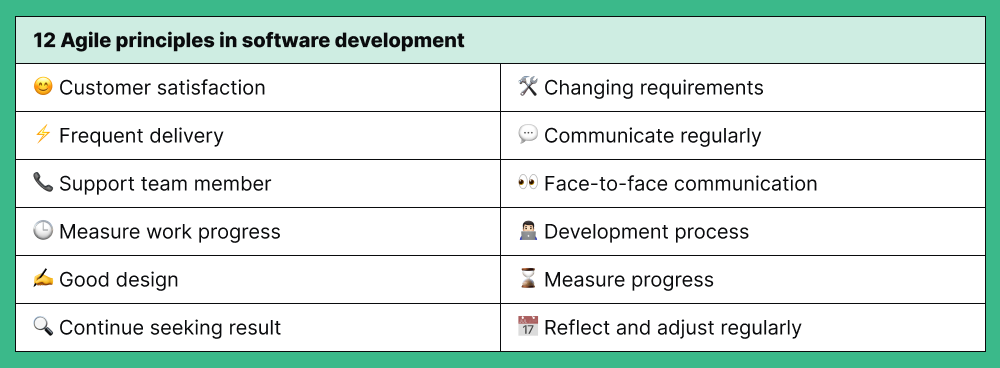
What is the ideal profile of an agile tester?
These principles contribute to the definition of an ideal Agile tester profile. Generally, Agile testers possess the following characteristics:- Acute communication skills
- A diverse, technical-based skillset
- Familiarity with a variety of testing tools and test automation
- An ability to effortlessly collaborate with others
- A willingness to embrace change
- An ability to liaise with everyone from DevOps to business analysts
- Broad experience in exploratory testing
- A results-oriented personality
- A passion for delivering value in business
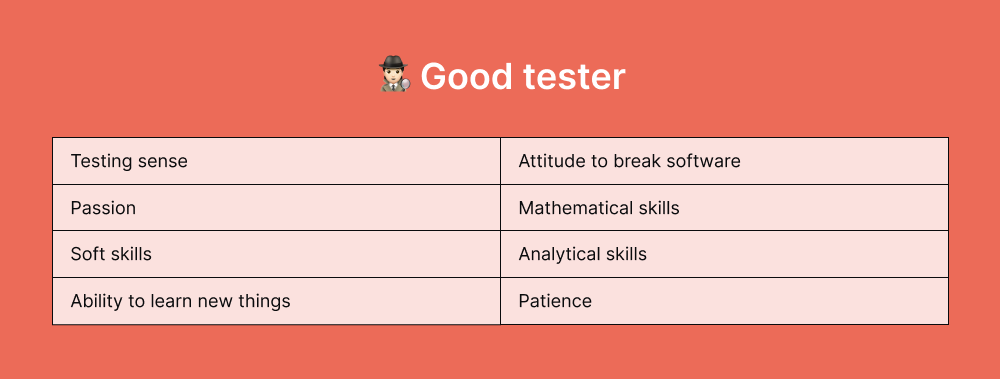
4 Types of Testing in Agile
Several methodologies have been developed for Agile testing processes. Here, we highlight four of the most popular Agile testing methods currently in use. While no single methodology is perfect for every product, these frameworks serve as valuable starting points for creating a customized approach:
1. Acceptance test-driven development
ATDD, or Acceptance Test-Driven Development, is a variation of TDD (Test-Driven Development). It emphasizes the collaborative essence of Agile testing by involving customers, developers, and testers in crafting acceptance tests from the customer's perspective. The process dictates that corresponding functionality is developed only after creating these tests. This workflow simplifies the creation of test cases, providing developers with direct insight into customer expectations and product usage. By eliminating ambiguity, it reduces the likelihood of significant errors.

2. Behavior-driven development
BDD is based on and enhances test-driven development and acceptance test-driven development. Using their structure adds the identification of correct business outcomes and performs tests based on those preferred outcomes. BDD has five stepsDescribe the behavior- Write the step definition
- Run and fail
- Write code to make the step pass
- Run and pass
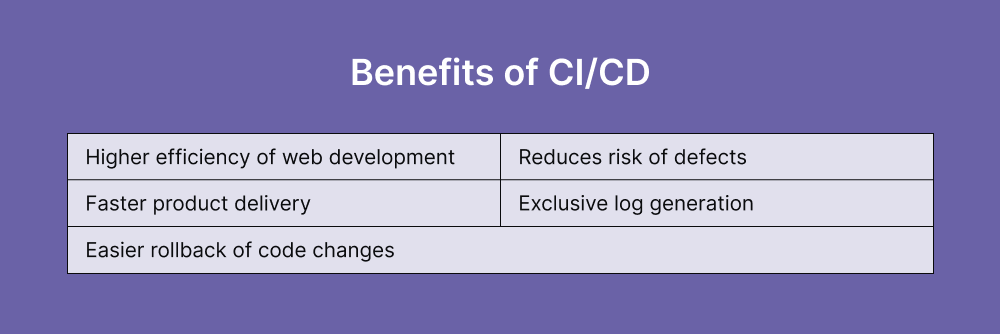
3. Exploratory Testing in Agile
Exploratory testing follows a cyclical process: from test design to test execution, analysis, learning, and then looping back. Unlike scripted tests, Agile testers generate tests dynamically as they explore the product, leveraging their unique skill set. Exploratory testing provides testers with an experience closest to how the product will appear 'in the wild.' It’s a great way to quickly find out if you have some working software, and it allows testers to identify bugs that would not be found through other testing methodologies.
4. Session-Based Testing
Like BDD does for ATDD, session-based testing builds on and refines exploratory testing. The strength of exploratory testing - the creativity of the people who do it - can also be its greatest weakness.
Session-based testing attempts to remedy this by adding structure. First, before a test session is begun, a charter is created. Second, uninterrupted testing sessions take place, focusing mainly on a single charter. The entire session is then reported on, and the manager is debriefed after the test. The additional structure ensures that all areas of the product are thoroughly tested, and avoids backlogs building in any particular area.
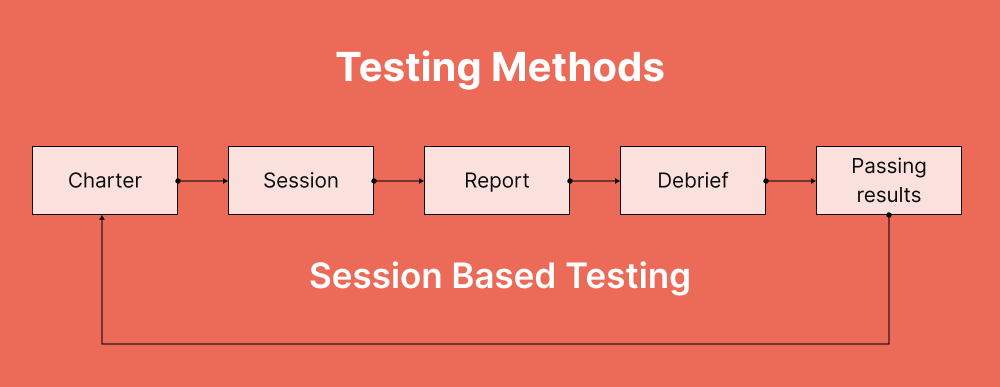
Agile Testing Quadrants
With these and other testing methodologies, it can be difficult to assess which type of test should be run, how often it should be run, when it should be run, and who it should be run by. There are so many types of tests - acceptance testing, regression testing, unit testing, and more. There’s also the question of whether manual or automated testing is better suited for the current iteration of the product.
Gregory and Crispin created the concept of Agile testing quadrants, which provide a taxonomy for tests. According to Crispin:
- The two left-hand quadrants help teams know which code to write and determine when they are done writing it.
- The two right-hand quadrants help teams learn more about the code they have written, providing feedback to the left-hand quadrants.
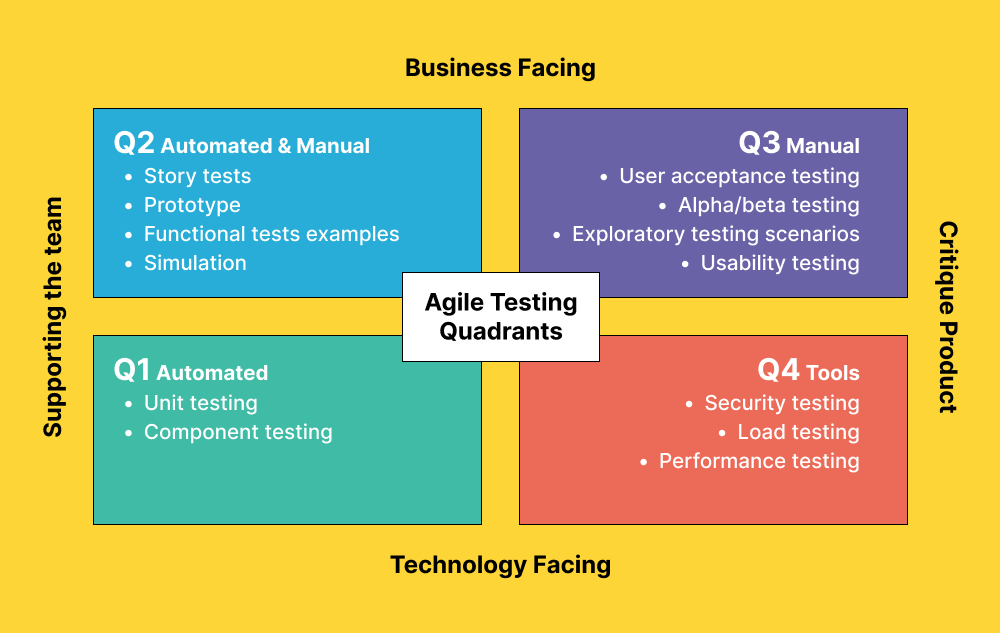
Q1 - The Automated quadrant contains tests that are designed to improve the code of the product being created; they are performed to help the team create a better product.
Q2 - The Automated & Manual quadrant contains tests that are designed to improve the business outcomes of the product being created; they are performed to help the team create a product that drives value for the business and for customers.
Q3 - The Manual quadrant contains tests with the purpose of providing feedback for tests in quadrants 1 and 2 by testing the product and user experience to ensure business outcomes.
Q4 - The Tools quadrant contains tests that use technology to ensure the code fulfills all nonfunctional requirements such as security and compatibility.
Agile testing life cycle
The Agile testing life cycle is an iterative process that aligns with the overall Agile software development life cycle. It includes various phases that focus on continuous testing, collaboration, and improvement.
The agile testing life cycle comprises five distinct phases:
- Impact assessment: Initiating the cycle, this phase, also known as the feedback phase, involves collecting inputs and responses from users and stakeholders. It helps test engineers set objectives for the upcoming phase.
- Agile testing planning: During this collaborative phase, developers, customers, test engineers, and stakeholders work together to plan testing process schedules, regular meetings, and deliverables.
- Release readiness: The third phase involves test engineers reviewing fully developed features to determine if they are ready for deployment. It assesses whether features are prepared for the go-live stage or if any need to be returned to the previous development phase.
- Daily scrums: Daily morning meetings are conducted in this phase to monitor testing progress and establish daily objectives. This allows test engineers to stay informed about the testing status.
- Test agility review: Concluding the agile testing lifecycle, this phase involves weekly meetings with stakeholders to evaluate and assess progress against established goals.
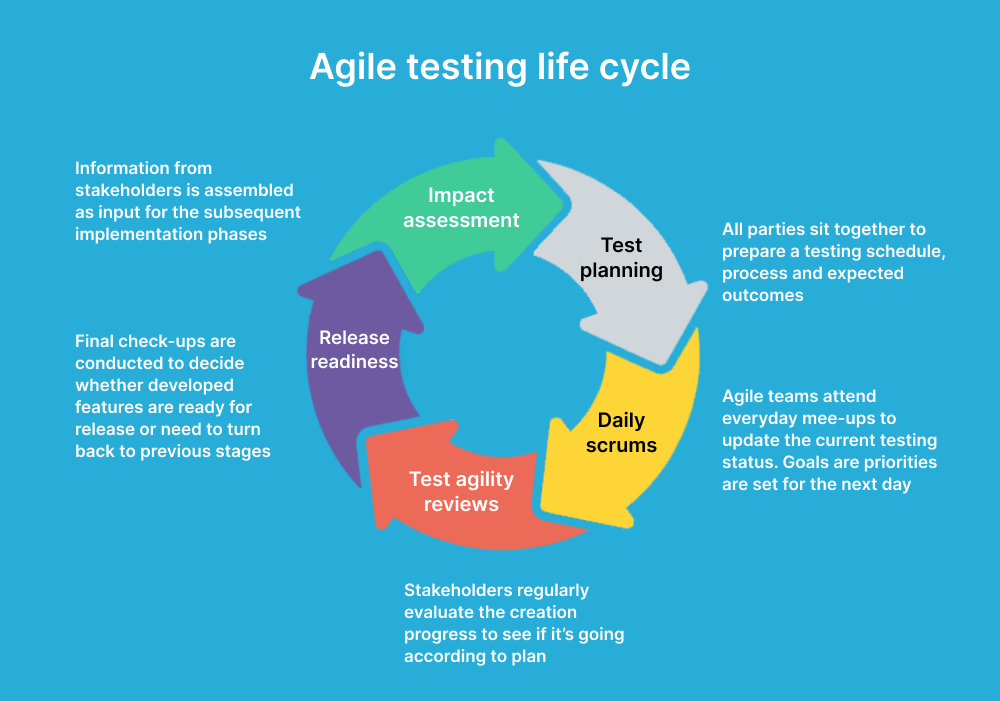
The Agile Testing Life Cycle iterates through these phases in alignment with the development sprints, promoting continuous improvement, rapid feedback, and ongoing collaboration. This approach allows the team to adapt to changes and deliver high-quality software throughout the development process.
Advantages of Agile Testing
Adopting Agile testing yields three straightforward yet impactful benefits: a happier team, higher-quality product, and faster delivery. The pursuit of this trifecta justifies the investment in crafting an efficient Agile testing framework.
1. A higher-quality product
Agile empowers testers to uncover defects early in development by implementing the principle of 'continuous feedback.' Testing begins simultaneously with development, allowing for promptly eliminating bugs as they emerge. Each product iteration undergoes thorough testing and debugging during creation, avoiding delays until completion. The involvement of every development team member leverages both developers' and testers' skills for the pursuit of an impeccable product. Continuous feedback and early and frequent testing results in testers gaining intricate knowledge of the product. Depending on the testing methodology employed, this knowledge can be combined with customer input to assist developers in crafting a superior product.
2. Fast delivery
In contrast to waterfall testing, where development and market release are often months or years apart, Agile testing methodology shortens the development cycle. This approach ensures continuous customer feedback, allowing the product to adapt to market needs during development and reach customers swiftly.
3. A happier team
Agile empowers testerThe final principle on the Agile testing list is intentional: enjoyment. Agile testing fosters tight collaboration among all team members, cultivating a happier, more enjoyable, and ultimately more productive workplace. Developers, testers, and customers collaborate closely to craft the best product and maximize value.
Crispin and Gregory say it best: "A team that guides itself with Agile values and principles will have higher team morale and better velocity than a poorly functioning team of talented individuals."
Real and perceived disadvantages of agile methodology
While Agile methodologies revolutionize development practices, they're not without their challenges. Recognizing potential pitfalls is crucial for ensuring a balanced perspective.Here are some downsides associated with Agile testing, shedding light on aspects that demand careful consideration.
- Weakened team structure: Improper implementation can undermine team cohesion and hinder product development.
- Inherent weaknesses: Even when correctly applied, Agile methodologies have weaknesses; for instance, exploratory testing may lack comprehensive structure, and ATDD might not fully consider business outcomes.
- People-centric challenges: The emphasis on people in Agile testing can backfire if testers are excluded from the closely integrated team, leading to ineffectiveness.
- Dependency on skilled testers: The departure of a skilled Agile tester can be a significant setback for product development.
- Hierarchy confusion: With everyone in the team involved in testing, a muddied hierarchy may result in confusion and conflict. Methodologies like Scrum aim to address this with 'scrum masters,' but there's a risk of reverting to a more traditional approach.
While Agile methodologies offer numerous benefits for software development, they also have some disadvantages when it comes to testing. Here are a few potential drawbacks of testing in Agile:
- Time constraints: Agile emphasizes rapid development cycles with short iterations or sprints. This time constraint can put pressure on testing efforts, leading to reduced testing time or inadequate coverage. As a result, some defects might be overlooked or remain undetected until later stages.
- Incomplete documentation: Agile values working software over comprehensive documentation. While this approach enhances flexibility, it can lead to inadequate documentation of test cases, test plans, and other testing artifacts. This may cause difficulties for future reference or when new team members join the project.
- Frequent changes: Agile projects often involve continuous change and iteration, including modifications to requirements, design, and functionality. These changes can impact testing efforts, requiring testers to adapt quickly and modify test cases accordingly. It may introduce additional complexities and potential rework for the testing team.
- Limited regression testing: Agile methodologies emphasize delivering new features in each iteration, which may lead to limited time and resources for regression testing. As a result, previous functionality may not receive thorough regression testing, increasing the risk of introducing regressions or breaking existing features
- Lack of end-to-end testing: Agile teams usually focus on testing individual user stories or small increments of functionality within each sprint. This approach may neglect end-to-end testing, where all components are tested together to ensure seamless integration and system-level functionality.
- Dependencies on development progress: In Agile, testing is closely intertwined with development. If development activities face delays or are incomplete, it can impact testing efforts and hinder timely completion. Testers may need to wait for development to finish before they can commence testing, affecting overall project timelines.
Agile testing strategy – overcoming challenges and maximizing benefits
Embarking on the Agile testing journey requires dedication, but the rewards are powerful. However, blind adoption without considering its appropriateness can lead to a weak, crash-prone product. Let's explore situations where Agile testing may not be the ideal fit:
- Crystal-clear project scope: If your project scope is well-defined and unlikely to change significantly, the dynamic nature of Agile may not provide added advantages.
- Single product owner dominance: In projects governed by a single product owner or stakeholder with minimal requirements, the collaborative and iterative nature of Agile may not align with the streamlined decision-making process.
- Skill set limitations: Agile testing demands deep, broad skills. Traditional testing methods might be more suitable if your team lacks the necessary expertise.
- Customer preference for waterfall: Agile may face resistance when the customer insists on a traditional waterfall approach, where testing follows development sequentially.
1. Select an Agile methodology that aligns with your project's needs, considering options like Scrum, Kanban, or Extreme Programming.
2. Create a robust testing process using the four-quadrant model to ensure comprehensive coverage.
To foster collaboration and prevent tester exclusion:
- Testers should work as closely as possible with developers, fostering regular interactions and keeping everyone on the same page.
- An iterative approach in both testing and collaboration helps build connections early on, paving the way for smoother collaboration later.
- Testers should provide valuable feedback to developers and customers, making themselves indispensable for seamless collaboration.
Conclusion: ensuring the success of agile testing
To ensure success in Agile testing, it's crucial to hire individuals with the key traits of an Agile tester and establish a culture that encourages self-organization and independent thinking across the organization. This approach brings significant advantages:- Balancing Stability and Speed: Cultivating a culture of self-organization naturally leads to a stable infrastructure without slowing down the development pace.
- Faster Delivery, Happier Teams: Empowering employees with autonomy not only boosts job satisfaction but also enables faster delivery of high-quality products.
- Satisfying Customers: The combination of speed and stability aligns with customer expectations, leading to increased satisfaction.
The categorization of Agile metrics remains dynamic, undergoing constant evolution and restructuring. However, three primary types of Agile metrics have gained prominence across various Agile frameworks over the years:
- Kanban metrics: Centered on gauging invested time (cycle times) and delivered outcomes (throughput), emphasizing the ratio between the two.
- Scrum metrics: Focused on planning, comprehending workflow, and illustrating the volume of work accomplished within a specific timeframe.
- Lean metrics: Involves ongoing measurement of production efficiency and product quality, incorporating technical assessments through testing features, error checks, and anticipation of adverse effects.

When testing in an agile environment, it's important to focus on metrics that provide meaningful insights into the quality, progress, and effectiveness of testing activities. Here are some of the most appropriate metrics to consider:
1. Test coverage
This metric measures the extent to which the test cases cover the requirements and functionality of the system. It helps identify gaps in test coverage and ensures that critical areas are adequately tested.
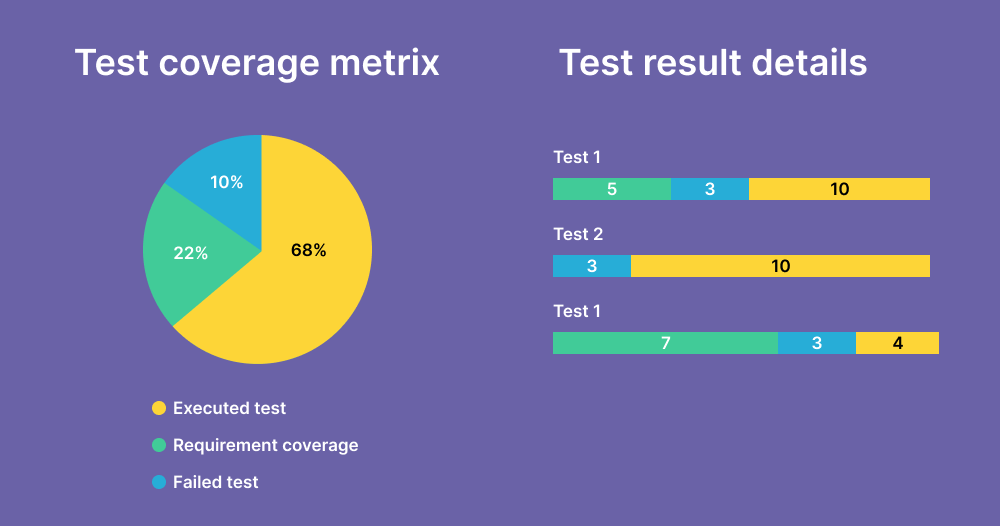
2. Defect density
Defect density measures the number of defects identified per unit of code or functionality. It helps assess the effectiveness of testing by indicating how many defects are found in relation to the amount of tested code.
3. Test execution progress
This metric tracks the progress of test execution within a sprint or iteration. It provides visibility into the percentage of test cases executed and helps identify any bottlenecks or delays in testing activities.
4. Test execution efficiency
This metric measures the ratio of passed tests to the total number of tests executed. It indicates the efficiency of the testing process by highlighting how many tests are passing successfully and how many are failing.
5. Cycle time
Cycle time measures the time it takes for a user story or a task to move through the entire testing process, from creation to completion. It helps identify bottlenecks and optimize the testing workflow.
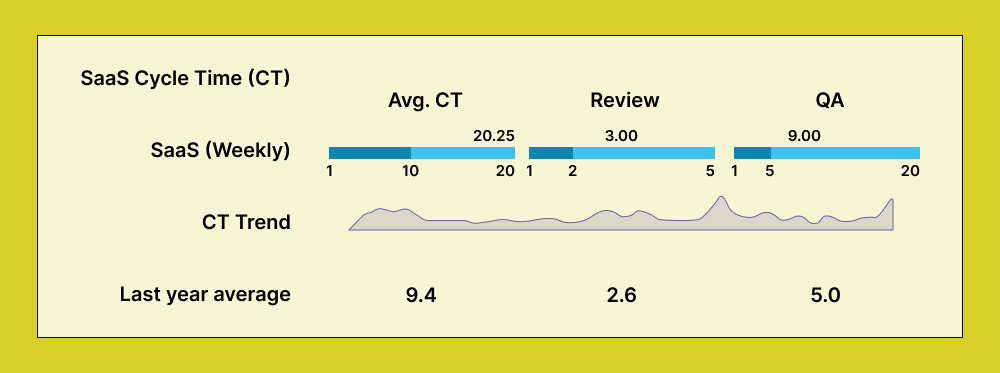
6. Defect turnaround time
This metric measures the time taken to identify, report, fix, and retest a defect. It helps assess the effectiveness of defect management and the overall responsiveness of the team in addressing issues.
7. Customer satisfaction
Although not directly related to testing, customer satisfaction is a crucial metric to gauge product quality. Feedback from customers and stakeholders can provide valuable insights into the effectiveness of testing efforts.
8. Agile test velocity
Test velocity measures the rate at which testing tasks or user stories are completed within an iteration. It helps the team understand their capacity for testing and provides insights into the progress of testing activities.
9. Escaped defects
Escaped defects are defects that are identified by customers or end-users after the software has been released. Tracking and analyzing escaped defects helps identify areas of improvement in testing and quality assurance processes.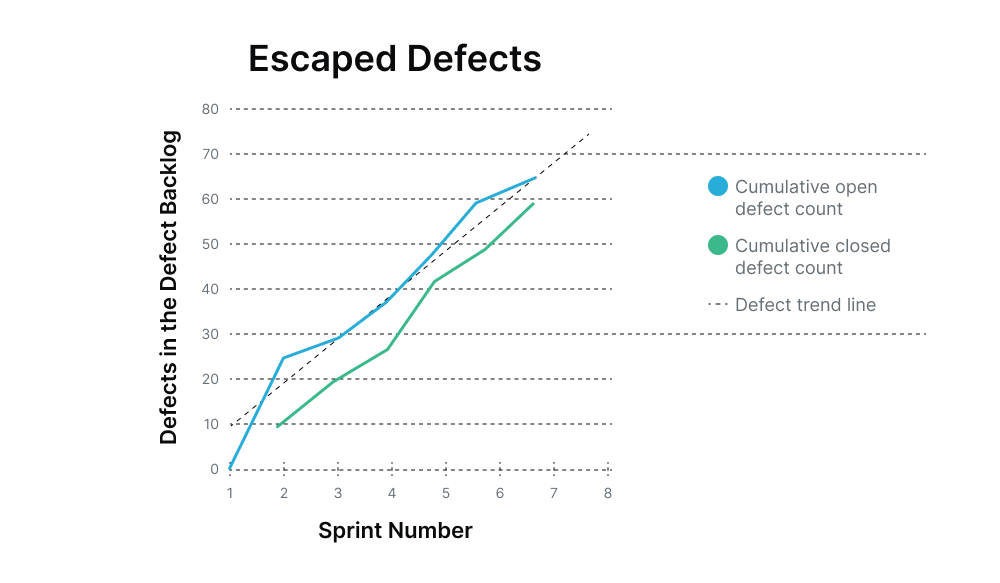
Remember, metrics should be used judiciously and in conjunction with qualitative assessments. Developers can leverage these insights to enhance efficiency in subsequent sprints, continually refining the product's quality. Nevertheless, it's essential to recognize that while development metrics are valuable, they shouldn't overshadow the primary focus on project requirements and audience preferences.
ConclusionThe Agile Method has emerged as a highly appealing project management methodology in software development and beyond. Its intrinsic flexibility and responsiveness to change position it as the ideal approach for project management in the 21st century. Despite potential drawbacks, when employed effectively by a team committed to its principles, the benefits of Agile Methodology are manifold.
The imperative for adaptability in the face of uncertainty has become evident, and as we look ahead, uncertainties persist.
While Agile methodology may not be universally suitable for every project, its principles can be judiciously applied to any project type, enabling teams to remain agile and resilient in the face of diverse challenges.
Here is the summarized version of best practices for Agile testing:
Best practices |
Description |
| Early and Continuous testing | Begin testing early in the development cycle. Conduct continuous testing throughout the project. |
| Collaboration and communication | Foster collaboration among developers, testers, and stakeholders. Maintain open communication channels. |
| Test automation | Prioritize automation for repetitive and critical test cases. Use automated testing tools for efficiency. |
| Cross-functional teams | Form cross-functional teams with diverse skills. Encourage collaboration among team members. |
| Adaptability to change | Embrace changes in requirements and priorities. Adjust test cases and plans accordingly. |
| User-centric testing | Focus on user stories and scenarios to align testing with user expectations. Prioritize features based on user needs. |
| Continuous integration and deployment | Implement continuous integration practices for frequent code merging. Aim for continuous deployment to deliver smaller increments. |
| Regular retrospectives | Conduct regular retrospectives to reflect on the testing process. Identify areas for improvement and implement changes iteratively. |
| Test environment management | Maintain well-configured test environments mirroring production. Ensure efficient collaboration between development and testing environments. |
| Risk-based testing | Prioritize testing efforts based on risk analysis. Identify high-risk areas and allocate testing resources accordingly. |
If your team wants to speed up how they make software, do it well, and stay ahead of the competition, think about using agile testing. When done right, agile testing gives you flexibility, lets you react quickly, and helps you deliver good results fast. If you're interested in exploring further insights on delivering quality at speed, schedule a call with one of our Growth specialists today.
Agile testing FAQ
What is Agile testing, and why is it important?
Agile testing is a methodology that integrates testing practices within the Agile development lifecycle. It's crucial because it ensures continuous feedback, early bug detection, and faster adaptation to changes, contributing to a more efficient and responsive development process.
How does Agile Testing differ from traditional testing methods?
Agile Testing is iterative, conducted concurrently with development, and emphasizes collaboration among developers, testers, and stakeholders. Unlike traditional methods, it's adaptable to changing requirements and encourages continuous improvement throughout the development lifecycle.
What are the key principles of Agile testing?
Agile testing principles include continuous testing, early bug detection, collaboration, adaptability to changes, and frequent feedback. These principles aim to deliver a high-quality product in a time-sensitive and flexible manner.
How can Agile testing be integrated into the development process?
Agile testing is integrated by involving testers in all stages of development, conducting testing iteratively, using test automation, and fostering collaboration among team members. Regular retrospectives help in refining the testing process.
Is test automation essential in Agile testing?
Yes, test automation is crucial in Agile Testing. It helps achieve faster feedback, continuous testing, and efficient regression testing. Automated tests contribute to the overall speed, accuracy, and repeatability of the testing process.
How can Agile testing be scaled for large projects or distributed teams?
Scaling Agile Testing involves breaking down large projects into smaller, manageable tasks, using collaboration tools, implementing continuous integration, and ensuring effective communication among distributed teams. Agile frameworks like SAFe (Scaled Agile Framework) can also be adopted.

